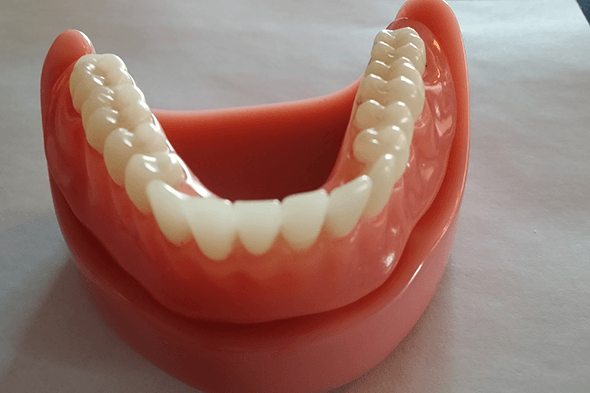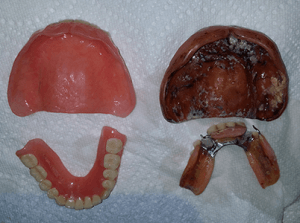Dentures

Dentures are used to replace teeth when there are no teeth remaining. Each patient’s denture is unique. They are custom made using impressions of the patient’s own gum tissue and bone ridge for proper fit and comfort. The teeth themselves come in many sizes, shapes and shades, and once selected, will be permanently secured to an acrylic base.
There are usually 5 steps to making a denture.
Step 1
A complete examination of the patient’s jaws and soft tissue both inside and outside of the mouth is done, including an oral cancer screening.
Step 2
A highly accurate impression of the patient’s jaw structure is taken as the patient bites down on a tray filled with soft impression material.
Step 3
Using the impression, the lab creates a wax model to establish the proper bite and placement of the denture’s teeth. The appropriate shape, size and shade of the teeth are selected for the denture.
Step 4
At this stage the lab sets the pre-made plastic teeth into the wax model according to the dentist’s instructions. The bite and placement is checked and the esthetics are evaluated and agreed upon by the dentist and the patient.
Step 5
Fitting of the completed dentures. The lab has now permanently secured the pre-made teeth onto a hard, tissue colored acrylic base. If necessary, the dentist will make adjustments to the fit and bite.
There will be a follow up appointment within 3 to 4 days after delivery of the dentures to again examine the fit and comfort.
Take Time To Get Used To Your New Denture:
If this is the patient’s first denture, it will take some time to get accustomed to them. A complete denture will feel different than their own teeth did, but in time should be comfortable and functional.
Speaking:
With practice, the patient will quickly adapt to speaking and enunciating their words. Every patient adjusts at their own rate.
Eating:
It is important to remember that chewing may feel different. Natural teeth chew in an up and down motion, while dentures use a side to side motion. Cut food in smaller pieces to make chewing with dentures more effective. All patient’s improve with practice; allow the new dentures to help you enjoy meals again!
Denture Fit:
It will take time to get used to new dentures, since they need time to “settle in”. Upper dentures usually fit snugly and stay in with suction. The lower denture does not develop this suction due to the different shape of the lower jaw. Therefore, the lower denture has a tendency to “float.” Denture adhesives can help, but these are NOT recommended during the first few weeks of wearing your new dentures.
Caring For New Dentures
- Keep your dentures clean by brushing them with toothpaste and a soft bristle brush at least once per day. It is best to do this over a soft surface such as a towel, to protect them in case they are dropped.
- Remove dentures every night and place them in a denture bath with water and a Polident tablet.
Follow Up Care
It is very important to have AT LEAST one annual dental appointment to examine the dentures, as well as the bone and tissue of the mouth. An oral cancer screening should also be done.
During the appointment we can also determine if the patient should have their dentures relined to ensure proper fit and comfort. Weight loss, often associated with aging, can affect the fit of the dentures. If a loved one loses weight, dentures like their clothing, will fit differently. Improper fitting dentures can rub or slip causing oral sores. We know from experience that this can affect a patient’s willingness to eat, causing further weight loss and possible health concerns.
Mobile Dentistry of Arizona 2733 N Power Rd., Suite #102-449 Mesa, AZ 85215
Phone: 480-313-3310 Fax: 480-772-4032

